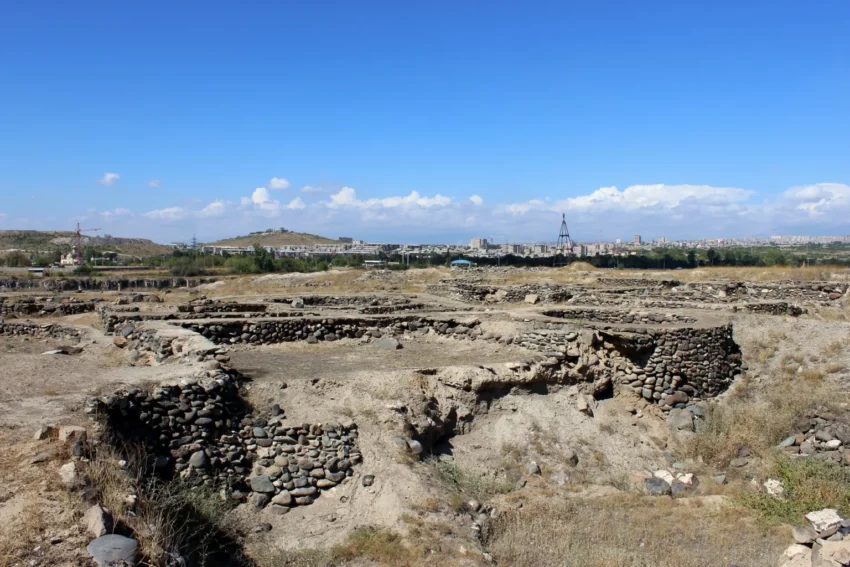Get your dose of History via Email
An Overview of Shengavit Settlement
The Shengavit Settlement is an archaeological site located in Yerevan, Armenia, that dates back to the Kura-Araxes culture during the Early Bronze Age, primarily between the 4th and 3rd millenniums BC. This significant historical site provides substantial evidence of the cultural and societal advances of the time, offering insights into the lives of the peoples of the region and their development.
Historical Significance
Archeological excavations at Shengavit have revealed a myriad of artifacts and structural remains that paint a detailed picture of the ancient settlement’s society. The Kura-Araxes culture, to which the Shengavit Settlement is attributed, is known for a distinctive red-black ceramic ware, which is a hallmark find at the site. The settlement layout includes round and rectangular dwellings, workshops, and sophisticated irrigation and metallurgy systems, indicating an advanced societal structure.
The discovery and study of Shengavit have been crucial in understanding the Bronze Age cultures of the South Caucasus and their relationship with neighboring regions. This provides archaeologists and historians with a more comprehensive view of the trade, cultural exchange, and influence of the Kura-Araxes peoples.
Archaeological Discoveries
Initially excavated between 1936 and 1938 under the guidance of the archaeologist Yevgeny Bayburdyan, Shengavit has undergone a series of excavations throughout the 20th century and into the 21st. Various periods of activity, sometimes with large gaps between, have included work in the 1950s, led by Koriun Meghretsyan, and in the 2000s, led by Hakob Simonyan, together with an American-Armenian archeological team.
The site has yielded monumental findings that consist of large numbers of early Bronze Age artifacts, including stone tools, metal objects, bones of domesticated and wild animals, wheat and barley remains, four charred kilns, and a plethora of pottery fragments. These artifacts help illustrate a comprehensive understanding of the everyday life, economy, and crafts of the Shengavit inhabitants.
Chronology and Cultural Layers
Shengavit serves as a veritable palimpsest of the Kura-Araxes culture, with at least four chronological phases identified within the Early Bronze Age, which correspond to a sequence of cultural layers at the site. Cultural deposits have revealed a consistent occupation sequence, without any significant stratigraphic breaks, from the 4th millennium to the beginning of the 3rd millennium BC. This uninterrupted occupation sequence offers researchers a unique window into the diachronic changes and continuities within a single Bronze Age culture.
Cultural and Urban Development
The site’s complex architectural design includes both circular and rectilinear buildings that suggest a high level of urban development and organization. Shengavit’s large area and its urban planning features point to the settlement acting as a regional hub or central settlement of the Early Bronze Age period. The archaeological evidence of metallurgical activity, in particular, suggests that Shengavit was possibly a center for the production and trade of metals, which would have been a significant economic resource at the time.
Archaeological Excavation and Conservation Efforts
The management of the Shengavit site has been subjected to various troubles pertaining to the preservation and study of the remains. Over the years, there have been reports of neglect and inadequate storage of artifacts, leading to concerns about the long-term preservation of the site and the invaluable historical information it holds. Ongoing efforts continue to be made by various organizations to ensure the protection, restoration, and proper curation of the artifacts.
Despite the challenges faced, the Shengavit Settlement remains a crucially important archaeological site that continues to contribute to the global understanding of Early Bronze Age societies. The settlement provides essential clues to the cultural evolution of the ancient civilizations in the South Caucasus and their interactions within the broader Near Eastern context.
In Conclusion
The Shengavit Settlement stands as a testament to the advanced societal structures present in the Early Bronze Age. Through continuous archaeological work and preservation, this valuable historical site is an important link to the Kura-Araxes culture and offers a treasure trove of information for historians and archaeologists alike.
Sources:

